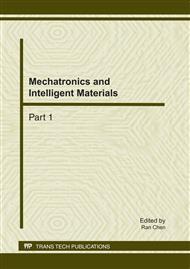[1]
L. O. Ajijolaiya, P. S. Hill, M. R. Islam. Qualitative Understanding of the Mechanism of Oil Mineral Interaction as Potential Oil Spill Countermeasure—A Review. Energy Sources, Part A, 29: 499–509. (2007).
DOI: 10.1080/009083190957649
Google Scholar
[2]
Ajijolaiya, L. O. The Effects of Mineral Size and Concentration on the Formation of Oil-mineral Aggregates. Unpublished Masters Thesis, Faculty of Engineering, Civil Engineering Department, Dalhousie University, Halifax, Canada, p.80. (2004).
Google Scholar
[3]
Guyomarch, J., Merlin, F., and Bernanose. Oil interaction with mineral fines and chemical dispersion: Behaviour of the dispersed oil in coastal or estuarine condition. Environment Canada's 22nd Arctic and Marine Oil Spill (AMOP) Technical Seminar, Calgary, Alberta, Canada, p.137–149. (1999).
DOI: 10.1016/s0304-3894(97)89406-x
Google Scholar
[4]
Kepkay, P., Bugden, J. B. C., Lee, K., and Stoffyn-Egli, P. Application of ultraviolet fluorescence (UVF) spectroscopy to monitor oil-mineral aggregate (OMA) formation. Spill Sci. Technol. Bull. 8: 101–108. (2003).
DOI: 10.1016/s1353-2561(02)00122-6
Google Scholar
[5]
Le Floch, S., Guyomarch, J., Merlin, F., Stoffyn-Egli, P., Dixon, J., and Lee, K. The influence of salinity on oil-mineral aggregate formation. Spill Sci. Technol. Bull. 8: 65–71. (2003).
DOI: 10.1016/s1353-2561(02)00124-x
Google Scholar
[6]
Demian E. Wincele1, Brian A. Wrenn, and Albert D. Venosa. Sedimentation of Oil-Mineral Aggregates for Remediation of Vegetable Oil Spills. Journal of Environmental Engineering. P50-58. (2004).
DOI: 10.1061/(asce)0733-9372(2004)130:1(50)
Google Scholar
[7]
McCourt, J., and Shier, L. Interaction between oil and suspended particulate matter in the Yukon River. Proc., 1999 Int. Oil Spill Conf., 1252. American Petroleum Institute, Washington, D.C., 1249–1252. (1999).
DOI: 10.7901/2169-3358-1999-1-1249
Google Scholar
[8]
Meyers, P. A., and Oas, T. G. 'Comparison of associations of different hydrocarbons with clay particles in simulated seawater. ' Environ. Sci. Technol., 12~8!, 934–937. Meyers, P. A., and Oas, T. G. 1978. 'Comparison of associations of different hydrocarbons with clay particles in simulated seawater. ', Environ. Sci. Technol., 12~8!, 934–937. (1978).
DOI: 10.1021/es60144a005
Google Scholar
[9]
Jiranun Hempoonsert, Berrin Tansel, Shonali Laha. Effect of temperature and pH on droplet aggregation and phase separation characteristics of flocs formed in oil-water emusions after coagulation. Colloid and Surface A: Physicochem. Enh. Aspects 353(2010).
DOI: 10.1016/j.colsurfa.2009.10.016
Google Scholar
[10]
Berrin Tansel and Frank Vilar. Enhancement of media filter performance with coagulant use for treatment of diesel oil contaminated surface water. Desalination 173(2005)69-76.
DOI: 10.1016/j.desal.2004.08.028
Google Scholar
[11]
S. Abend, N. Bonnke, U. Gutschner, G. Lagaly. Stabilization of emulsions by hetorocoagulation of clay minerals and layered double hydroxides. Colloid Polym Sci 276: 730-737(1998).
DOI: 10.1007/s003960050303
Google Scholar
[12]
B. Meyssami, A.B. Kasaeian. Use of coagulants in treatment of olive oil wastewater model solutions by induced air flotation. Bioresource Technology 96(2005)303-307.
DOI: 10.1016/j.biortech.2004.04.014
Google Scholar
[13]
Huang,C., Chen,Y. Coagulation of colloid particles in water by chitosan. J. Chem. Tech. Biotechnol. 66, 227-232. (1996).
Google Scholar
[14]
Pablo Canizares, Fabiola Martinez, Carlos Jimenez, et al. Coagulation and electrocoagulation of oil-in-water emulsions. Journal of Hazardous Material 151(2008)44-51.
Google Scholar
[15]
Berrin Tansel, Orhan Sevimoglu. Coalescence and size distribution characteristics of oil droplets attached on flocs after coagulation. Water, Air, and Soil Pollution(2006)169: 293-302.
DOI: 10.1007/s11270-006-3110-3
Google Scholar
[16]
Rossman F. Giese, Carel J. van Oss. Colloid and surface properties of clays and related materials. Surfactant science series, Volume 105. P21. (2002).
Google Scholar
[17]
George R. Alther, Biomin. Organoclay filtration technology for oil removal. Fluid/Particle Seperation Journal, Vol. 12, No. 2, (1999).
Google Scholar
[18]
Jiangjun Liu, Zhenghe Xu, Jacob Masliyah. Role of fine clays in bitumen extraction from oil sands. Materials, Interfaces, and Electrochemical Phenomena. Vol. 50, No. 8. 1917-1927. (2004).
DOI: 10.1002/aic.10174
Google Scholar


